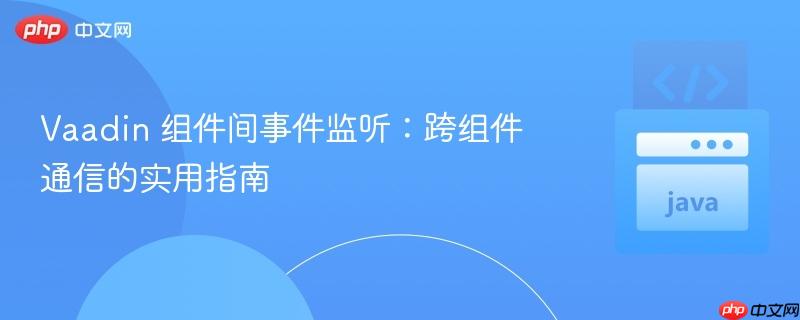
本文旨在解决 Vaadin 应用中跨组件事件监听的问题,特别是如何在不同组件(例如主视图和对话框)之间传递事件并进行响应。通过使用 UI 事件总线,我们能够实现组件间的解耦,并确保事件能够被正确地触发和处理。本文将提供详细的代码示例和步骤,帮助开发者理解和应用这一技术。
在 Vaadin 应用开发中,组件间的通信是一个常见的需求。例如,一个对话框组件关闭后,我们可能需要在主视图中更新 UI。直接在组件之间建立依赖关系会导致代码耦合度增加,维护困难。Vaadin 提供了 UI 事件总线,可以很好地解决这个问题。
UI 事件总线允许组件发布事件,而其他组件可以订阅这些事件。这样,组件之间无需直接引用,降低了耦合度。
1. 定义事件类
首先,我们需要定义一个事件类,用于携带需要传递的信息。
import com.vaadin.flow.component.ComponentEvent;
import com.vaadin.flow.component.Component;
import com.vaadin.flow.component.DomEvent;
import com.vaadin.flow.component.EventData;
import com.vaadin.flow.component.html.Div;
public class ComponentCloseEvent extends ComponentEvent<Component> {
public ComponentCloseEvent(Component source, boolean fromClient) {
super(source, fromClient);
}
}2. 在发布事件的组件中触发事件
在需要触发事件的组件(例如对话框)中,使用 ComponentUtil.fireEvent() 方法来发布事件。
import com.vaadin.flow.component.Component;
import com.vaadin.flow.component.ComponentUtil;
import com.vaadin.flow.component.button.Button;
import com.vaadin.flow.component.dialog.Dialog;
import com.vaadin.flow.component.orderedlayout.VerticalLayout;
import com.vaadin.flow.router.Route;
public class CustomDialog extends Dialog {
public CustomDialog() {
Button closeButton = new Button("Close", e -> {
ComponentUtil.fireEvent(this, new ComponentCloseEvent(this, true));
close();
});
add(closeButton);
}
}3. 在订阅事件的组件中监听事件
在需要监听事件的组件(例如主视图)中,使用 UI.getCurrent().addBroadcastListener() 方法来注册事件监听器。 为了保证UI事件总线可用,需要保证监听器在onAttach之后注册。
import com.vaadin.flow.component.Component;
import com.vaadin.flow.component.UI;
import com.vaadin.flow.component.button.Button;
import com.vaadin.flow.component.dialog.Dialog;
import com.vaadin.flow.component.orderedlayout.VerticalLayout;
import com.vaadin.flow.router.Route;
@Route("")
public class MainView extends VerticalLayout {
private Button openDialogButton;
public MainView() {
openDialogButton = new Button("Open Dialog", e -> {
CustomDialog dialog = new CustomDialog();
dialog.open();
});
add(openDialogButton);
}
@Override
protected void onAttach(com.vaadin.flow.component.AttachEvent attachEvent) {
UI.getCurrent().addBroadcastListener(ComponentCloseEvent.class, event -> {
// 在这里处理事件
System.out.println("Dialog closed!");
// 例如,显示一个加号按钮
Button plusButton = new Button("+", e -> {
CustomDialog dialog = new CustomDialog();
dialog.open();
});
add(plusButton);
});
}
}代码解释:
以下是一个完整的示例,展示了如何使用 UI 事件总线在 Vaadin 应用中进行组件间通信。
// ComponentCloseEvent.java
import com.vaadin.flow.component.ComponentEvent;
import com.vaadin.flow.component.Component;
public class ComponentCloseEvent extends ComponentEvent<Component> {
public ComponentCloseEvent(Component source, boolean fromClient) {
super(source, fromClient);
}
}
// CustomDialog.java
import com.vaadin.flow.component.ComponentUtil;
import com.vaadin.flow.component.button.Button;
import com.vaadin.flow.component.dialog.Dialog;
public class CustomDialog extends Dialog {
public CustomDialog() {
Button closeButton = new Button("Close", e -> {
ComponentUtil.fireEvent(this, new ComponentCloseEvent(this, true));
close();
});
add(closeButton);
}
}
// MainView.java
import com.vaadin.flow.component.UI;
import com.vaadin.flow.component.button.Button;
import com.vaadin.flow.component.orderedlayout.VerticalLayout;
import com.vaadin.flow.router.Route;
@Route("")
public class MainView extends VerticalLayout {
private Button openDialogButton;
public MainView() {
openDialogButton = new Button("Open Dialog", e -> {
CustomDialog dialog = new CustomDialog();
dialog.open();
});
add(openDialogButton);
}
@Override
protected void onAttach(com.vaadin.flow.component.AttachEvent attachEvent) {
UI.getCurrent().addBroadcastListener(ComponentCloseEvent.class, event -> {
// 在这里处理事件
System.out.println("Dialog closed!");
// 例如,显示一个加号按钮
Button plusButton = new Button("+", e -> {
CustomDialog dialog = new CustomDialog();
dialog.open();
});
add(plusButton);
});
}
}通过使用 UI 事件总线,我们可以实现 Vaadin 组件间的解耦通信。这使得代码更加模块化,易于维护和测试。 本文提供了一个简单的示例,展示了如何使用 UI 事件总线来监听对话框关闭事件,并在主视图中更新 UI。 在实际项目中,可以根据需要扩展事件类,传递更多信息,并实现更复杂的组件间交互。 掌握 UI 事件总线的使用,将大大提高 Vaadin 应用的开发效率和代码质量。
以上就是Vaadin 组件间事件监听:跨组件通信的实用指南的详细内容,更多请关注php中文网其它相关文章!

每个人都需要一台速度更快、更稳定的 PC。随着时间的推移,垃圾文件、旧注册表数据和不必要的后台进程会占用资源并降低性能。幸运的是,许多工具可以让 Windows 保持平稳运行。

Copyright 2014-2025 https://www.php.cn/ All Rights Reserved | php.cn | 湘ICP备2023035733号